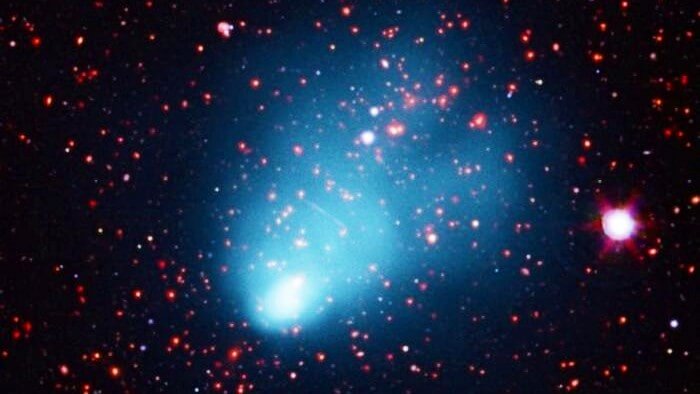A recent study published in “Astronomy & Astrophysics” (A&A) by Riccardo Valdarnini of SISSA’s Astrophysics and Cosmology group challenges the standard model’s view that dark matter is non-interacting.
Through numerical simulations, Valdarnini analyzed the behavior of dark matter within “El Gordo,” a giant cluster merger located seven billion light years away. The results indicate that the observed physical separation between the points of maximum density of dark matter and those of other mass components in this cluster can be explained using the Self-Interacting Dark Matter (SIDM) model, rather than the standard model.
According to the currently accepted standard cosmological model, dark matter accounts for 90% of the Universe’s total matter content, with baryonic matter making up the remaining 10%. Dark matter is generally thought to be non-baryonic and composed of cold, collisionless particles that respond only to gravity, hence the name “Cold Dark Matter” (CDM). However, there are still observations that the standard model has not been able to explain, leading some researchers to propose the SIDM model as an alternative.
Massive Galaxy Clusters: Unique Laboratories for Studying Dark Matter
Proving the collisional properties of dark matter and testing alternative theories to the standard cosmological model is a complex task. However, massive galaxy clusters, which are gigantic cosmic structures that collide and produce the most energetic events since the Big Bang, can serve as unique laboratories for this purpose. “El Gordo,” with a mass of about 10^15 solar masses, is one of the largest known galaxy clusters and has been the subject of numerous theoretical and observational studies due to its peculiarities.
In the standard paradigm, during a cluster merger, the behavior of the collisional gas mass component differs from that of the galaxies and dark matter. The gas dissipates part of its initial energy, causing the peak of gas mass density to lag behind those of dark matter and galaxies after the collision. However, the SIDM model predicts a peculiar phenomenon: the physical separation of dark matter centroids from those of other mass components, which represents a true “signature of SIDM models.” Observations of “El Gordo” align with this prediction.
Simulations Provide Compelling Evidence for Self-Interacting Dark Matter
To validate the SIDM models and explain his findings, Valdarnini used a large set of N-body/hydrodynamical simulations to systematically study and reproduce the observational features of “El Gordo.” The most significant result of this simulation study is that the relative separations observed between the different mass centroids of the “El Gordo” cluster are naturally explained if the dark matter is self-interacting.
“For this reason, these findings provide an unambiguous signature of a dark matter behaviour that exhibits collisional properties in a very energetic high-redshift cluster collision,” states Valdarnini.
However, there are inconsistencies, as the SIDM cross-section values obtained from these simulations are higher than present upper limits. This suggests that current SIDM models should be considered only as a low-order approximation and that the underlying physical processes describing the interaction of dark matter in major cluster mergers are more complex than can be adequately represented by the commonly assumed approach based on the scattering of dark matter particles.
The study makes a compelling case for the possibility of self-interacting dark matter between colliding clusters as an alternative to the standard collisionless dark matter paradigm. Valdarnini’s research contributes significantly to the ongoing debate about the nature of dark matter and its role in the formation and evolution of cosmic structures.


